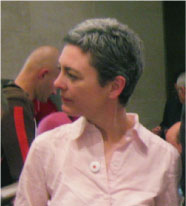 |
||||||||
 |
||||||||
 |
||||||||
 |
||||||||
 |
||||||||
 |
||||||||
|
|
||||||||
Simona Nastac: How would you define your interest in Romanian contemporary art and where it comes from? How did your interest in Romanian contemporary art change through out and after the trip?
Sian Bonell: I was very curious and interested in meeting and seeing contemporary work in Romania. Having had a fine art education in the late 70's 2 of the biggest influences on my work were Romanian, Constantin Brancusi and Paul Neagu. My expectations were largely influenced by my having returned just four days earlier from a month long residency in Brno in the Czech Republic so I expected the work to be quite retrospective and traditional.
I was pretty impressed overall with much of the work that I saw; there was a lot of dreadful work too (particularly in the Artists Union spaces) but the work being produced particularly by the young artists I thought was very direct and honest and free from the much of the arch cynicism often found in contemporary Western European work. This was very refreshing and was brought home to me the day after I returned from Romania when I visited the Frieze Art Fair in London.
I think my interest in Romanian art changed at the beginning of the visit because I was very impressed with the contemporary work that I have mentioned and that interest has remained and grown.
S.N.: Have you seen works by or met Romanian artists in the UK or in international art events before coming to Romania?
S.B.: Only as I have already mentioned in question one – as I did not attend the Biennale in Venice and British art press only really covered UK work.
S.N.: You visited Bucharest, Iasi and Cluj, the most active contemporary art centres in Romania. What, in your opinion, were the situations and scenes for contemporary art in these cities?
S.B.: I found it interesting that on the whole the most interesting work was happening outside of the capital. As a generalization, in Bucharest the emphasis seems more commercial and traditional although there are exceptions particularly in the work of the Perjovschis and especially Ioana Nemes. I was totally impressed with Matei Bejenaru’s own work and the ‘Periferic’ Biennial in Iasi and also with Idea Magazine in Cluj and the work of Mihai Pop and Ciprian Muresan also in Cluj. The situations particularly in Iasi and Cluj were more conducive to an art scene for contemporary art particularly Periferic and the project run by Matei and in Idea and the new artist run space we saw in Cluj.
S.N.: What do you think about the relationship between state-run/funded art institutions and independent initiatives in Romania?
S.B.: I think the independent initiatives are far more successful in terms of forward planning and reaching a wider audience and of course in the quality of work they show than the state run institutions. I found the state run venues very depressing partly because they do not seem to have any vision for anything long term. They appear more backward looking and also I had the overall impression that they have lost their way.
S.N.: How did you find the local art production and its historical, social, and economic contexts comparing with those in the UK or in the West at large?
S.B.: The work production certainly of the very strong contemporary initiatives compare very favourably with the UK. Historically of course, there is a huge difference in that the history both recent and distant is not there – that is why I was so impressed with the archive building and publishing of theories which we all take for granted, is so fantastic. Economically as well we are far more fortunate in UK and the west as art funding is relatively easy to acquire as are spaces to work in. I was very shocked that few young artists have a space to even think let alone to work. It is amazing that such good work is produced in Romania under these enormous difficulties.
S.N.: What do you think is missing here on the level of art practice, conceptual and visual discourse, and cultural policy? Are there elements that you find more desirable within in Romania than in the UK?
S.B.: The things that are missing are the freedoms for Romanian artists to travel and to experience different culture for themselves and also the lack of space in which to think and to work. Also the lack of trust between the states funded institutions and the independent ones. I think what is missing is that different groups across the creative community are isolated; they are not able to feel comfortable building a dialogue with the institutions. The state and the state institutions need to listen to the independent artists and curators.
S.N.: What is in excess? In your opinion, are certain areas of contemporary art in Romania over-saturated and others lacking? If so, what areas do you see this within?
S.B.: I don’t think I experienced enough to answer this. As is in UK and the west photography and video seemed very prevalent so it is a similar situation.
S.N.: Could you speak about a local specificity in Romanian contemporary art? Does it have a certain identity mark you could name and recognize it?
S.B.: I’m not sure about this. I think the aspects of archiving and collecting of information is pretty specific, as is the use of text.
S.N.: Do you have any suggestions to make to specific Romanian artists, curators and institutions?
S.B.: I don’t think I am in a position to offer suggestions. I think the only way things can change and improve is with collaboration. I think it is important for artists and institutions and curators to group together and collaborate together and especially form collaborations with curators, artists and institutions outside of Romania.
S.N.: Do you intend to initiate collaboration or exchange with Romanian art institutions and artists in the future? If so, please give details of what these projects may entail?
S.B.: Yes. I am collaborating with Kim Dhillon on a UK wide project to offer residencies to Romanian artists. We have only had very brief preliminary discussion – but we are very keen to do it. We are working on a small pilot scheme to offer 1 artist a studio on Portland in Dorset (it is on the beach) for a 6 week period in autumn 2006. The working title is ‘Bucharest on Sea’. We plan to use this pilot to fund raise and gain interest and support for a much larger residency series in 2-3 years time. We have already begun a discussion with Ben Borthwick at Tate Modern for this. At present it is all still in embryonic stage as I have been very tied up recently – but Kim and I are committed to do something and will be meeting in the new year.